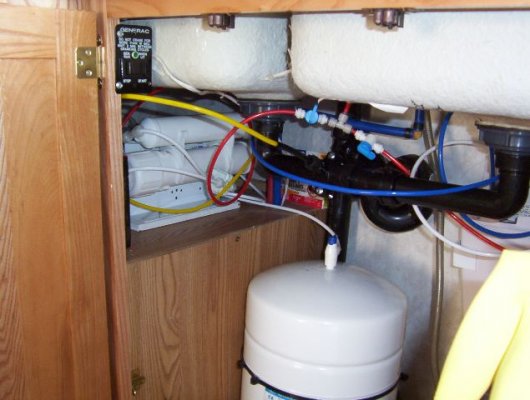Foto-n-T
Well-known member
Given the fact that we're spending the majority of our time in our 5th wheel I've taken to customizing it to suit our needs a little better than the factory. Items like an inverter to make boondocking more civilized or a accumulator on the water system to absorb pressure shocks etc. My latest little brain storm stems from the fact that we are currently in Lake Havasu City AZ where if you were to drink the tap water you would have to chew it BEFORE you swallowed. The RV park that we're in has an RO water machine very close by to our space but it got me to thinking....
On our sink is a water spigot that is connected to one of those cheapy 5 micron inline filters, we don't use it so it pretty much just takes up space. I'm wondering if any of you have ever installed a Reverse Osmosis system in your rig. There is one on the market that I've found that uses the fresh water tank as the holding tank but that seems a little extreme. I'm thinking a residential unit that holds 1/2 to 1 gallon in a pressure tank for drinking water basically. I like the idea of having the entire fresh tank filled with RO water but that presents the problem of stopping the flow when it's full, meaning that a float valve would have to be installed in a tank that is mounted above my triple axles in a 4-season rig, it's not someplace I want to explore shall we say.
By the way, I do have a 5 micron filtration system built into the city water inlet, this is also used to fill the fresh tank.
On our sink is a water spigot that is connected to one of those cheapy 5 micron inline filters, we don't use it so it pretty much just takes up space. I'm wondering if any of you have ever installed a Reverse Osmosis system in your rig. There is one on the market that I've found that uses the fresh water tank as the holding tank but that seems a little extreme. I'm thinking a residential unit that holds 1/2 to 1 gallon in a pressure tank for drinking water basically. I like the idea of having the entire fresh tank filled with RO water but that presents the problem of stopping the flow when it's full, meaning that a float valve would have to be installed in a tank that is mounted above my triple axles in a 4-season rig, it's not someplace I want to explore shall we say.
By the way, I do have a 5 micron filtration system built into the city water inlet, this is also used to fill the fresh tank.

